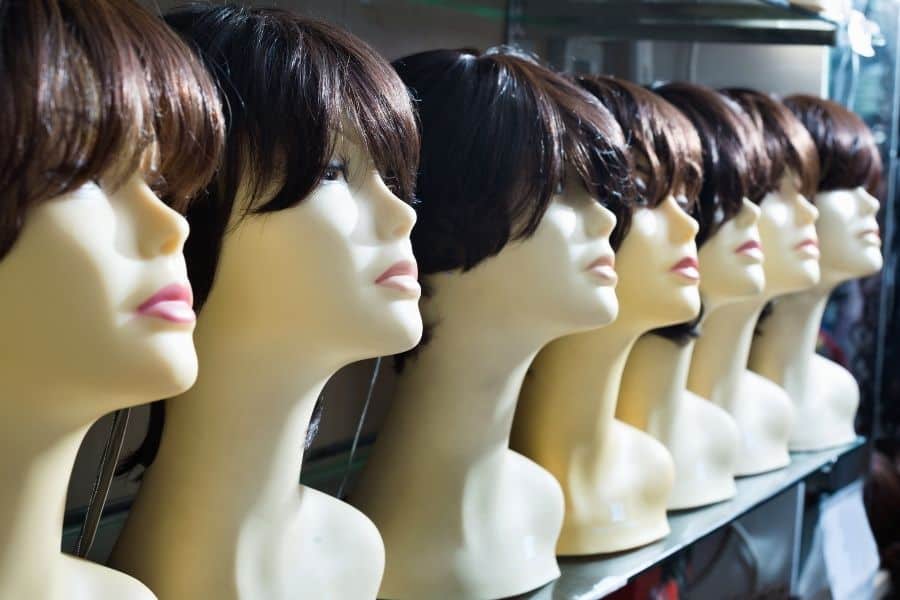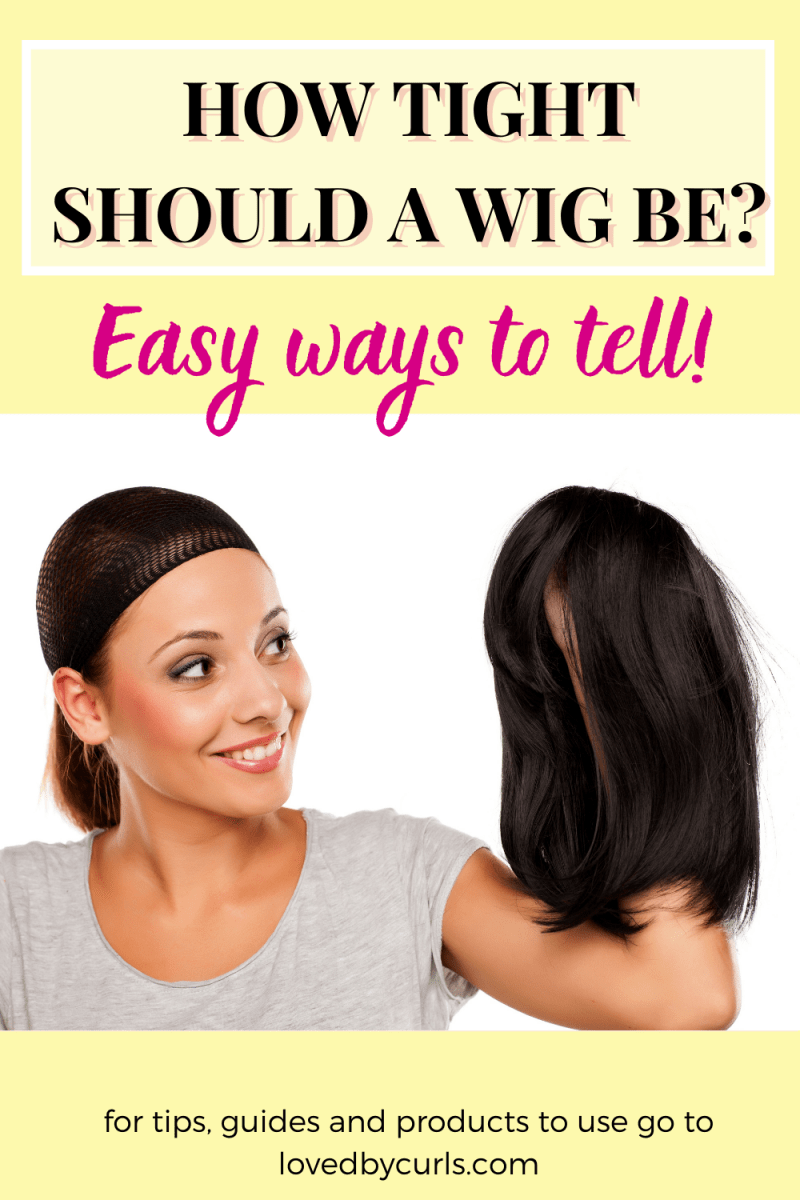How tight should a wig be and is there an easy way to tell? In this article, we explore the different types of wigs, a few helpful signs to determine if your wig size is right for you and how to make wearing one more comfortable.

If you’re wondering how tight your wig should be, the simple answer is that a wig should never be too tight. It should fit securely on your head without causing any discomfort to your scalp. An overly tight wig has the potential to cause headaches, breakages along the hairline and even hair loss.
This post contains affiliate links and we may earn if you click on them (at no extra cost to you). Please read our full disclosure policy here.
Get Meassured: How to Avoid Your Wig Being Too Tight
It’s important to get the correct head measurements as this will help to ensure a comfortable fit. To measure your head, you will need to use a tape measure and follow the easy steps below:
- Place one end of the tape on your forehead and hold it in place with your index finger. Using your other hand, wrap the tape measure around your head following your hairline. Take note of this measurement.
- Repeat the process but this time go to the back of your head, at the nape of your neck. Write this measurement down as well. These are the two main measurements you will need to determine the right size.
Wigs are generally available in three sizes – small, medium, and large.
- An ultra-small cap is usually under 20 inches.
- Small caps are around 21-inches.
- Medium caps are around 21.5 – 22.5 inches.
- A large cap fits heads larger than 22.5 inches
Putting on Your Wig The Right Way:
A simple way to put on a wig would be to do it in the same way you would put on a ski cap.
- Hold the front area of the wig closest to your body, then bend it over and flip it up onto your head
- Once on, pull the two metal pieces down until they are firmly in place
- Do the same with the two pieces located at the nape of your neck which will help to ensure a comfortable, natural-looking fit
Different Types of Wigs

Besides determining how tight your wig should be and the style, you also need to consider the different styles a wig could have, and which are the most suitable for your budget and lifestyle.
Full Lace Wigs
Full lace wigs are one of the most expensive wigs on the market. It consists of full lace and is very natural looking. The hair mimics your natural strands making it hard to tell that it is in fact a wig.
360 Frontal Wig
A 360 frontal wig consists of a cap on the crown area of the head and mesh material around the hairline.
It’s a versatile wig as you can style it in numerous ways including half-up styles, updos and high ponytails.
If you’re looking for a wig that is slightly more affordable than a full lace one, this wig is your best choice.
Lace Front Wig
These types of wigs have lace only in the front portion of the unit.
The rest of the cap is a little thicker and there might be clips sewn into it so that the wig stays firmly in place during wear.
Because the lace is only found in the front section of the wig, you can part the wig any way you want to.
If you like to wear your hair away from your face, a lace front wig is a perfect choice.
Human Hair Wigs
These wigs are authentic looking and very natural. They are made from natural hair and are extremely hard to detect. Whilst it is an expensive choice, they are a better choice over synthetic hair wigs.
Remy Human Hair Wigs
Remy human hair wigs are known to be the highest quality human hair wigs and for many, the best wigs overall.
You’re able to cut, curl and style these wigs as well as straighten and dye them. The cuticle layer is still intact in these wigs, which is the outer layer of each hair strand.
For this reason, the root and tip are in the same direction so that the cuticle doesn’t matte or tangle which is hugely beneficial for wig wearers.
Synthetic Hair Wigs
Synthetic hair wigs are a more affordable choice rather than real human hair wigs.
These wigs can still provide a realistic look and are a great option for those that have a smaller budget.
If you only intend to use the wig for a short term this may be the best option for you.
Capless Wigs
Capless wigs are also known as wefted wigs or open cap wigs.
The wig is machine-made and wefts or stands of hair are sewn into rows of hair strands to form the wig. It’s great for allowing airflow and has plenty of volume.
Also Read: Growing Edges: How To Avoid Thinning Hair With These 5 Tips
Signs Your Wig Is Too Small
- Your wig slides back on your head revealing your hairline
- In lace front wigs, the lace front rolls under when the wig is too small
- It feels very tight at your temple
Signs Your Wig Is Too Big
- Your wig slides around when you move your head
- You can see your own natural hair through the gaps the ear tabs create
- The lace wrinkles or buckles at the front of the wig
- If you move your head and the wig slides along with it, your wig is too big
Signs Your Wig Is Too Tight
- If your wig rides up or slips back on your head
- If your wig is pulling on your natural hair or on your skin too tight and squeezing the skin at your temples
- You’re not able to shake your head or lean backwards without your wig popping off
- You could suffer from headaches.
- If it squeezes your temples or pulls your biological hair, it’s too tight.
5 Handy Tips to Make Wearing A Tight Wig More Comfortable

1. Get Measured Before Buying Your First Wig
The best thing you can do to ensure that your first wig is comfortable for daily use is to try on a few and see how they feel.
This way you can get a better idea of the style that suits you before committing to a purchase.
Wigs are known to be non-returnable so selecting the wrong size or style can be a costly mistake.
You can then get a feel for how tight your wig should be and if a wig is too small or big for your specific head measurements.
2. Wear A Wig Cap To Avoid It Being Tight
A handy tip for first-time wig wearers is to wear a wig cap underneath your wig.
This will help to make your wig feel more comfortable and it will also alleviate any effects of long-term wear on your hair.
If you’re wondering how tight a wig should be, the answer has a lot to do with its size and your comfort levels.
If your wig were to be too tight it will continually rub on your scalp it could cause some discomfort as well as scalp irritations and possible hair loss.
The wig cap will act as a barrier between your scalp and your wig protecting your head from these effects.
Also Read: Will Hair Dye Kill Lice? All Your Questions Answered!
3. Take A Break From Daily Wear If It’s Too Tight
Sometimes a day off from wearing your wig can go a long way.
It will help to relieve some of the pressure on your head and prevent the possibility of headaches.
To help preserve your wig’s shape, remove it at night while sleeping and store it in a safe place.
Wigs are also known to cause damage and breakage to your natural hair due to the constant friction.
A break will also help to combat this issue and allow your hair to breathe and recover.
4. Wear A Silicone Wig Grip
A great hack to making your wig feel more comfortable is to invest in a silicone wig grip.
It fits around your head similar to that of a headband. It will act as a grip for your wig and prevent movement and friction on your hairline and scalp.
5. Style Your Hair Correctly Under The Wig
To make your wig sit more comfortably and to make a great foundation for your wig it’s important to take note about how you style your hair under the wig.
Wrap your hair carefully, making sure to brush it out and for there to be no tangles. This is a simple way to prevent possible itchiness and discomfort during wear and for your wig to sit more comfortably.

Disclaimer: This site is not intended to provide professional or medical advice. All of the content on LovedByCurls.com is for informational purposes only. All advice should be followed at your own discretion. Ingredients may change at any time so always check the product label before using. Check our full disclaimer policy here.
